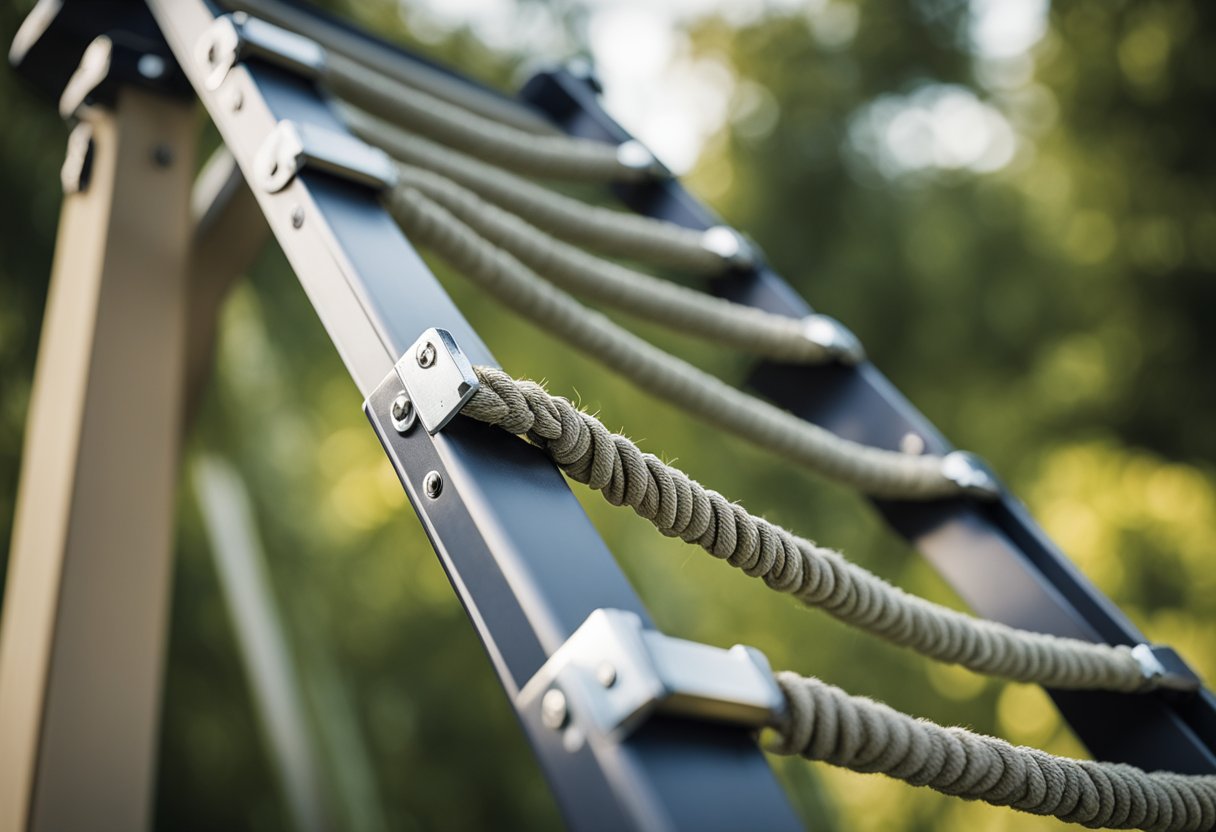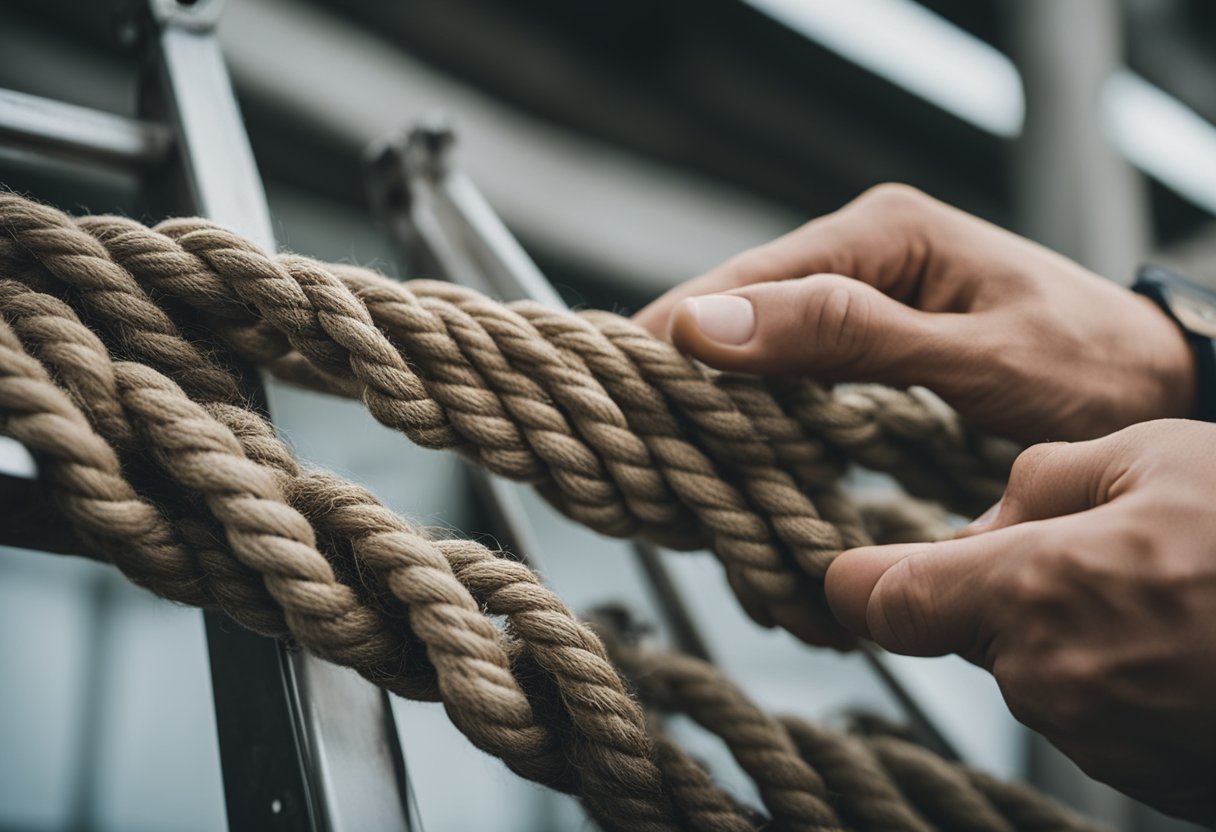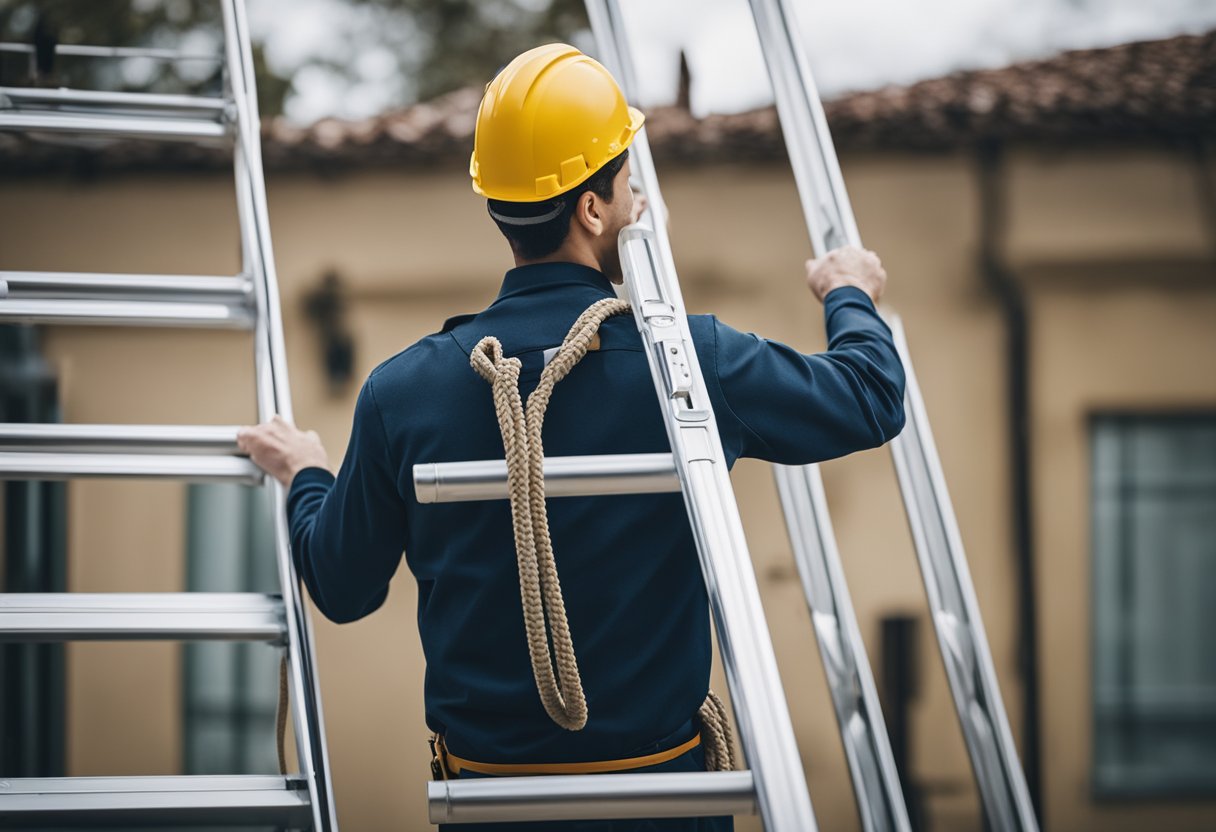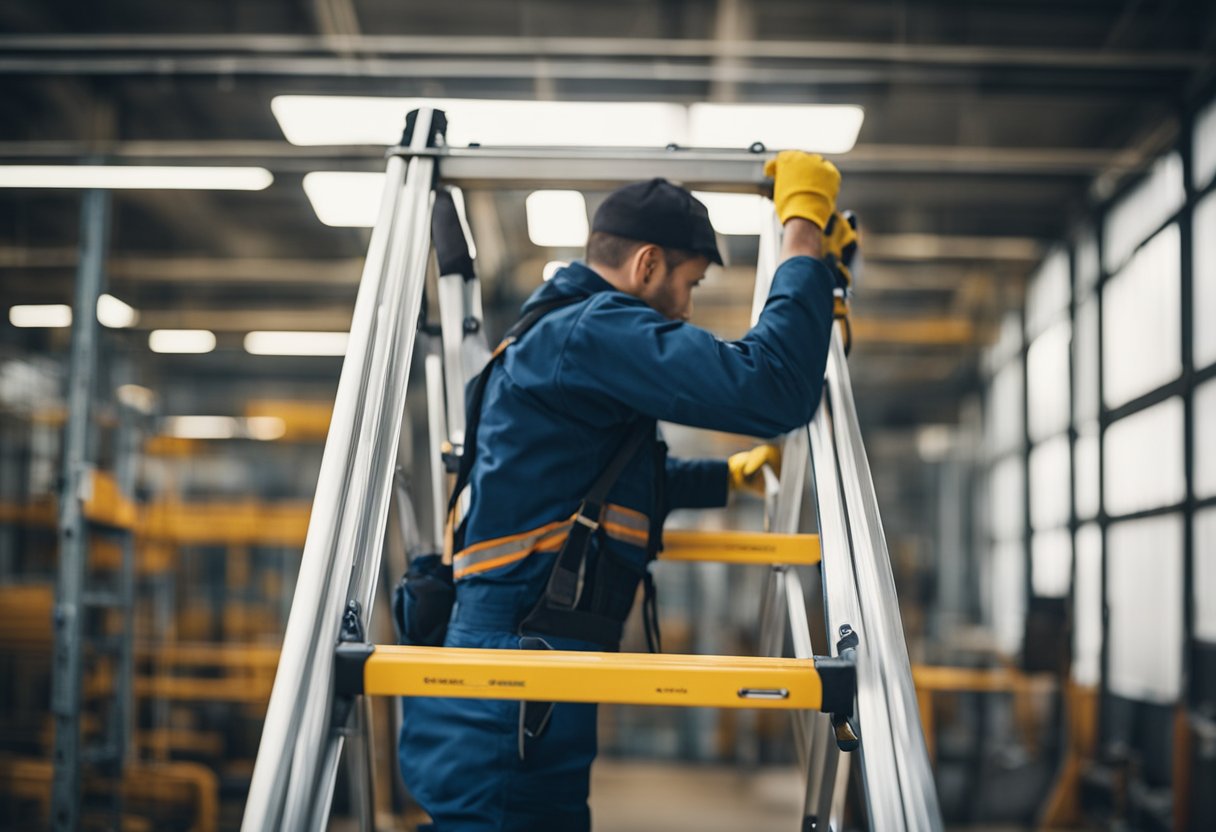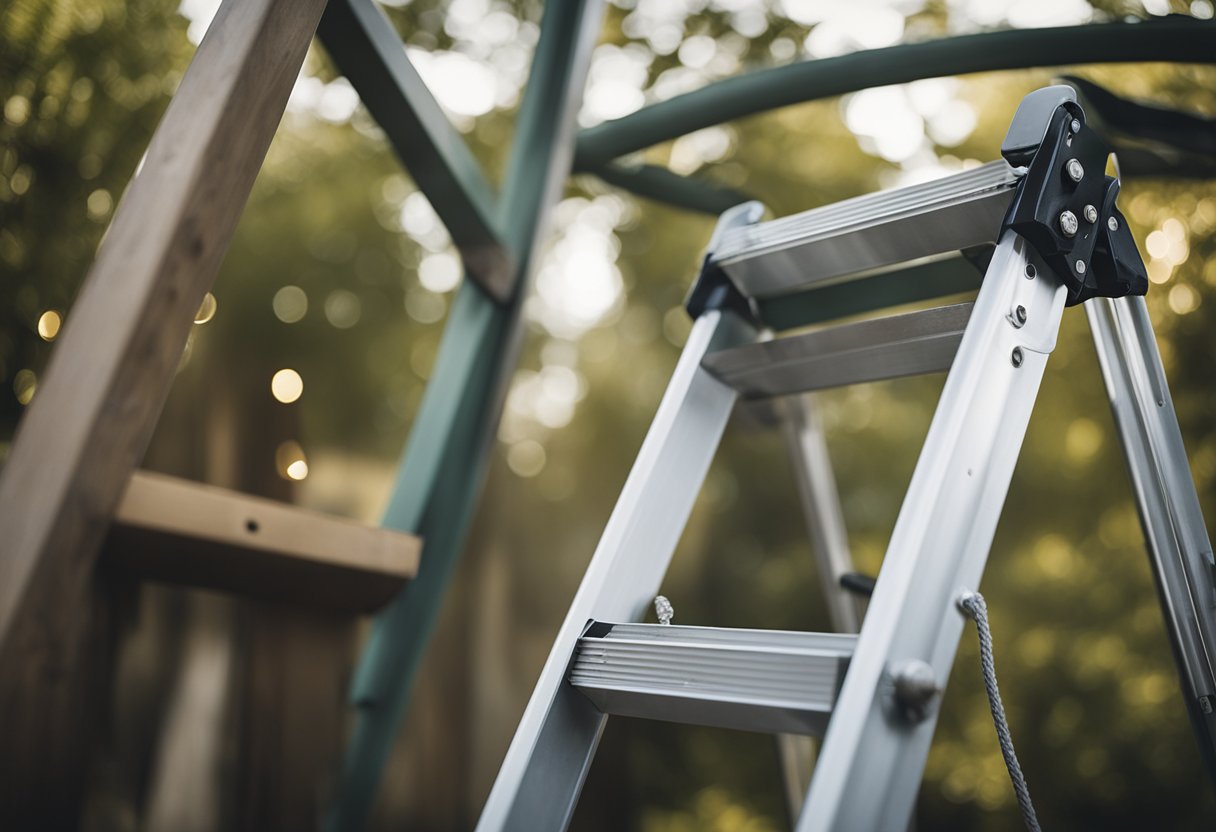Replacing the rope on an extension ladder is a task that every homeowner should know how to do. Over time, the rope can wear out, fray, or even break, making the ladder unsafe to use. By replacing the rope, you can ensure that your ladder is safe and functional for years to come.
Safety is of the utmost importance when working with ladders. Before beginning any ladder-related task, it is crucial to take the necessary safety precautions. This includes wearing proper footwear, using gloves to protect your hands, and having a helper hold the ladder steady. By following these safety guidelines, you can minimize the risk of accidents and injuries.
Key Takeaways
- Safety is essential when working with ladders.
- Removing the old rope and choosing the right replacement rope are crucial steps in the process.
- Checking the ladder’s functionality and maintaining the rope can extend the ladder’s lifespan.
Safety Precautions
https://www.youtube.com/watch?v=GKNG_Ymf_dk&embed=true
When replacing the rope on an extension ladder, it is important to take certain safety precautions to prevent accidents and injuries. Here are some tips to keep in mind:
Wear Protective Gear
Before starting the process of replacing the rope, it is important to wear the appropriate safety gear. This includes gloves to protect your hands from rope burns and other injuries. It is also important to wear non-slip shoes to prevent slipping and falling.
Follow Ladder Safety Guidelines
It is important to follow ladder safety guidelines when working with an extension ladder. This includes placing the ladder on a stable surface, securing the ladder at the top and bottom, and not overreaching when on the ladder. It is also important to use a ladder that is the appropriate height for the job.
Mark the Ladder
Before removing the old rope, it is important to mark the ladder to ensure that the new rope is installed correctly. This can be done by using a marker to make a small mark on the rung where the old rope was attached. This will help ensure that the new rope is installed in the correct location.
By following these safety precautions, you can ensure that the process of replacing the rope on an extension ladder is done safely and effectively. Remember to always prioritize safety when working with ladders to prevent accidents and injuries.
Identifying the Ladder Model
Before replacing the rope on an extension ladder, it is important to identify the ladder model. This information is necessary to ensure that you purchase the correct type and length of rope.
In my experience, the best way to identify the ladder model is to look for the manufacturer’s label. The manufacturer’s label is typically located on the side rail of the ladder and provides important information such as the model number, length, and weight capacity.
If you have a Werner ladder, the model number is usually located on the blue label on the side of the ladder. The model number is a combination of letters and numbers, such as “D6224-2”. This information is important to ensure that you purchase the correct replacement rope for your ladder.
In addition to the manufacturer’s label, you can also identify the ladder model by its features. For example, Werner ladders have distinctive yellow shoes and black end caps. The shape and size of the ladder may also be unique to a particular model.
Once you have identified the ladder model, you can purchase the correct replacement rope. It is important to purchase a rope that is the same diameter and length as the original rope. Using the wrong size or type of rope can compromise the safety and stability of the ladder.
In summary, identifying the ladder model is an important first step in replacing the rope on an extension ladder. Look for the manufacturer’s label or distinctive features to determine the model number and purchase the correct replacement rope.
Removing the Old Rope
https://www.youtube.com/watch?v=M8Aa5HTL1eE&embed=true
When it comes to replacing the rope on an extension ladder, the first step is to remove the old rope. This may seem like a daunting task, but it is actually quite simple with the right tools and technique.
To begin, I recommend gathering the following items: a utility knife, scissors, and duct tape. These tools will come in handy when removing the old rope and preparing the ladder for the new rope.
The first thing I do is locate the free end of the old rope and pull it until I finally get to unloop the rope from the ladder. It is important to note that there is no way to replace a rope when it is still installed on the ladder. So, you need to remove the rope and set it apart.
Once the old rope is removed, I inspect the ladder for any damage or wear and tear. If there are any issues, I address them before installing the new rope. This ensures that the ladder is safe to use and will last for years to come.
Overall, removing the old rope is a simple process that can be completed with the right tools and technique. By following these steps, you can ensure that your extension ladder is safe and ready for use.
Choosing the Replacement Rope
When it comes to replacing the rope on your extension ladder, choosing the right replacement rope is crucial. The wrong rope can lead to safety hazards and accidents, so it’s important to choose a rope that is durable, strong, and reliable.
There are several types of ropes that can be used to replace the rope on an extension ladder, including polypropylene and woven nylon. Both of these materials are strong and durable, making them ideal for ladder replacement rope.
Polypropylene is a synthetic material that is lightweight and resistant to water and chemicals. It is also resistant to UV rays, making it ideal for outdoor use. Polypropylene is a popular choice for ladder replacement rope because it is affordable and easy to work with.
Woven nylon is another popular choice for ladder replacement rope. Nylon is a strong and durable material that is resistant to wear and tear. It is also resistant to UV rays, making it ideal for outdoor use. Woven nylon is a bit more expensive than polypropylene, but it is also stronger and more durable.
When choosing a replacement rope, it’s important to consider the diameter of the rope. The diameter of the rope should be the same as the original rope on the ladder. This ensures that the rope will fit properly and work effectively.
In summary, choosing the right replacement rope is crucial when replacing the rope on your extension ladder. Polypropylene and woven nylon are both strong and durable materials that are ideal for ladder replacement rope. When choosing a replacement rope, it’s important to consider the diameter of the rope to ensure that it fits properly.
Installing the New Rope
https://www.youtube.com/watch?v=1RvbebraV4s&embed=true
Now that I have removed the old rope, it’s time to install the new one. The first step is to measure the length of the new rope. I will need to add a few extra feet to the length of the rope to make sure that it is long enough to reach the ground. Once I have measured the length of the rope, I will need to secure it to the pulley system.
To secure the new rope, I will need to tie a secure knot at the end of the rope. I prefer to use a figure-eight knot because it is strong and easy to tie. Once the knot is tied, I will need to thread the rope through the pulley system. It’s important to make sure that the rope is threaded correctly through the pulley system to ensure that it will function properly.
Once the rope is threaded through the pulley system, I will need to tie another secure knot at the other end of the rope. This knot will prevent the rope from slipping out of the pulley system. I will need to make sure that the knot is tied tightly and securely.
Finally, I will need to test the new rope to make sure that it is functioning properly. I will pull on the rope to make sure that it is secure and that it does not slip. If the rope is secure, I will be ready to use my extension ladder again.
In conclusion, installing a new rope on an extension ladder is a simple process that can be completed in just a few steps. By measuring the length of the new rope, securing it to the pulley system, and tying secure knots, I can ensure that my extension ladder is safe and functional.
Checking the Ladder Functionality
https://www.youtube.com/watch?v=R9A32C_GII8&embed=true
Now that I have replaced the rope on my extension ladder, it’s important to ensure that the ladder is functioning properly before using it. Checking the ladder’s functionality will help prevent accidents and ensure that the ladder is safe to use.
The first thing I do is to check the ladder’s slide and rungs. I make sure that the slide moves smoothly and that the rungs are secure. If any of the rungs are loose, I tighten them immediately. I also check the ladder sections to ensure that they are locked in place. If the ladder sections are not locked in place, it can cause the ladder to collapse, leading to serious injuries.
Next, I check the ladder base. The ladder base is the part of the ladder that rests on the ground. I make sure that the ladder base is stable and that the ladder is not wobbling. If the ladder is wobbling, it can cause the ladder to tip over, leading to serious injuries.
I also check the ladder height to ensure that it is appropriate for the task at hand. If the ladder is too short, I can’t reach the area I need to work on, and if the ladder is too tall, it can become unstable. I make sure that the ladder rung is at least three feet above the roofline or working surface.
Finally, I check the ladder rung. The ladder rung is the step on which I stand. I make sure that the ladder rung is clean and free of debris. If the ladder rung is dirty or covered in debris, it can cause me to slip and fall.
In conclusion, checking the ladder’s functionality is an essential step to ensure that the ladder is safe to use. By following these steps, I can prevent accidents and ensure that the ladder is functioning properly.
Preventing Rope Fraying
https://www.youtube.com/watch?v=cbWi5GKRTzc&embed=true
As someone who has replaced the rope on my fair share of extension ladders, I know that fraying is a common issue that can cause problems down the line. Fortunately, there are a few simple steps you can take to prevent fraying and ensure that your ladder is safe and secure.
One of the most effective ways to prevent fraying is to use a thimble. A thimble is a small metal sleeve that is inserted into the eye of the rope, providing a smooth surface that prevents the rope from rubbing against the ladder. This can help to extend the life of the rope and prevent fraying from occurring.
Another option is to wrap the end of the rope with duct tape. This can help to protect the rope from abrasion and prevent fraying. However, it is important to note that duct tape is not a permanent solution and will need to be replaced periodically.
In addition to using a thimble or duct tape, it is important to inspect the rope regularly for signs of wear and tear. If you notice any fraying or damage, it is important to replace the rope as soon as possible to prevent accidents from occurring.
Overall, preventing rope fraying is an important part of ladder safety. By using a thimble, duct tape, and regularly inspecting the rope, you can help to ensure that your ladder is safe and secure for years to come.
Maintaining Your Ladder
As a homeowner who frequently relies on extension step ladders to reach elevated areas, it’s essential to ensure that your ladder remains in optimal condition. Proper maintenance of your ladder can help prevent accidents and injuries, and also prolong its lifespan. Here are some tips to help you maintain your ladder:
Inspect Your Ladder Regularly
Before using your ladder, it’s essential to inspect it carefully to ensure that it’s still in good condition. Check for any cracks, dents, or other signs of damage. Make sure that all the bolts, nuts, and screws are tight. If you notice any issues, it’s best to address them immediately to prevent further damage.
Clean Your Ladder
Cleaning your ladder regularly can help prevent dirt and debris from accumulating on it. Use a mild detergent and a soft brush to clean the ladder thoroughly. Avoid using harsh chemicals or abrasive materials that could damage the ladder’s surface.
Replace Ladder Rope
Over time, the rope on your extension ladder may become worn or frayed, making it unsafe to use. Replacing the rope is a relatively simple process that can be done with the right tools and some basic knowledge. You can find detailed instructions on how to replace ladder rope on various websites, including Ladder Mentor and The Ladder Guide.
Use Safety Feet
Safety feet are essential accessories that can help prevent your ladder from slipping or sliding while in use. They are especially useful when working on uneven or slippery surfaces. You can purchase safety feet for your ladder at most home improvement stores.
Consider a Werner AC30-2 Extension Ladder Replacement Rope and Pulley Kit
If you’re looking for a high-quality replacement rope and pulley kit for your Werner AC30 extension ladder, the Werner AC30-2 Extension Ladder Replacement Rope and Pulley Kit is an excellent option. This kit includes everything you need to replace the rope and pulley system on your ladder, including detailed instructions.
By following these tips, you can help ensure that your ladder remains in optimal condition and is safe to use. Remember to always prioritize safety when using your ladder and take necessary precautions to prevent accidents and injuries.
Conclusion
In conclusion, replacing the rope on an extension ladder is a simple task that can be done in a few easy steps. It is important to replace the rope on your extension ladder when it shows signs of wear or aging to ensure ladder safety and prevent accidents.
When replacing the rope on your extension ladder, it is important to follow the necessary steps to ensure that the ladder is safe to use. This includes selecting the right rope, inspecting the ladder for any damage, and securing the rope on the ladder rungs.
Height is also an important factor to consider when replacing the rope on your extension ladder. Make sure to measure the height of the ladder to ensure that you select the right length of rope.
In addition, it is important to note that ladder safety is crucial when working at height. Always make sure to follow the necessary safety precautions when using a ladder, such as ensuring that the ladder is stable, using the ladder on a level surface, and using the ladder at the correct angle.
Finally, it is important to tighten the nut on the rope to prevent it from slipping. This will ensure that the rope is secure and that the ladder is safe to use.
Overall, replacing the rope on an extension ladder is a simple task that can be done by following a few easy steps. By ensuring ladder safety and taking the necessary precautions, you can prevent accidents and ensure that your ladder is safe to use.
Frequently Asked Questions
What is the best rope to use for an extension ladder?
The best rope for an extension ladder is a marine-grade rope that is strong and durable. Nylon and polypropylene ropes are also good options. The rope should be able to support the weight of the ladder and the person using it.
How do you replace the rope on an extension ladder?
To replace the rope on an extension ladder, you will need to remove the old rope and install the new one. The steps involved in replacing the rope will vary depending on the type of ladder you have. However, the general steps involve removing the old rope, measuring and cutting the new rope, attaching the new rope to the ladder, and securing the ends of the rope.
Where can I find replacement rope for my extension ladder?
You can find replacement rope for your extension ladder at hardware stores, home improvement stores, and online retailers. It is important to ensure that the rope you purchase is the correct size and strength for your ladder.
What is the purpose of a ladder rope clamp?
A ladder rope clamp is a device that is used to secure the rope to the ladder. It is designed to prevent the rope from slipping or coming loose while the ladder is in use. The clamp is typically made of metal or plastic and is attached to the ladder using screws or bolts.
Can an extension ladder be repaired if it comes apart?
If an extension ladder comes apart, it may be possible to repair it. However, the extent of the damage will determine whether or not the ladder can be repaired. If the damage is minor, such as a broken rung or a loose bolt, it may be possible to repair the ladder. However, if the damage is extensive, such as a broken rail or a damaged rope, it may be necessary to replace the ladder.
What is the recommended size for the rope on an extension ladder?
The recommended size for the rope on an extension ladder varies depending on the size and weight of the ladder. Generally, a 3/8-inch or 1/2-inch rope is suitable for most extension ladders. However, it is important to consult the manufacturer’s instructions or a professional to determine the appropriate size for your ladder.

Hi, I’m Sal Muller of Tooltrip.com. My DIY experience led me to understand essential power tools for home projects. Tooltrip.com guides enthusiasts and professionals in choosing right tools for any job. I provide concise top tool reviews for easier, efficient DIY.

